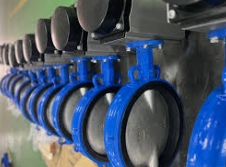

Inquiry

Project Review

Machining

Quality Control

Pass/Fail

Delivery
In water treatment engineering, valves are critical components for controlling flow direction, regulating flow rate, maintaining system pressure, and ensuring safe operation. Depending on the treatment process and operational requirements, commonly used valves include gate valves, ball valves, globe valves, check valves, and butterfly valves, each with its unique structure and application scenarios.
For example, gate valves are primarily used to completely shut off water flow, while butterfly valves serve both shutoff and throttling functions. Check valves prevent backflow, protecting pumps and pipeline systems, whereas globe valves are suitable for precise flow regulation but are not ideal for long-term throttling. Proper valve selection not only enhances water treatment efficiency but also extends equipment lifespan and ensures stable system operation.
Next, we will detail the structural features, applicable working conditions, and specific applications of these valves in water treatment engineering.
Classification of Water Treatment Methods
Depending on the treatment method, water treatment can be categorized into physical, chemical, and biological water treatment.
Based on the treatment objective, it can be divided into two major categories: water supply treatment and wastewater treatment.
· Water supply treatment includes potable water treatment and industrial water treatment.
· Wastewater treatment comprises domestic sewage treatment and industrial wastewater treatment.
Among these, processes closely related to thermal engineering include boiler feedwater treatment, makeup water treatment, turbine main condensate treatment, and circulating water treatment, all falling under industrial water treatment. Water treatment plays a vital role in industrial production, product quality improvement, environmental protection, and ecological balance.
What Is Water Treatment Engineering?

Water treatment engineering refers to the process of purifying, softening, disinfecting, removing iron/manganese, eliminating heavy metal ions, and filtering water to meet specific standards. Simply put, it involves physical and chemical methods to remove undesirable substances from water for production or domestic use. This includes processes such as sedimentation, filtration, coagulation, flocculation, corrosion inhibition, and scale prevention to condition water quality for specific applications.
Common Valves in Water Treatment Engineering
1. Gate Valve
Function: Shuts off water flow.
Feature: In rising-stem gate valves, the degree of opening can be determined by the stem height.
2. Ball Valve
Function: Used for shutoff, flow distribution, and changing flow direction.
Application: Typically serves as an on/off valve but is unsuitable for throttling. However, in a partially open state, it can reduce system pressure.
3. Globe Valve
Function: Primarily used to block or allow fluid flow in pipelines.
Advantage: Offers better flow regulation than gate valves.
Limitation: Not suitable for long-term pressure or flow control, as the sealing surface may erode, compromising performance.
4. Check Valve
Function: Prevents backflow in pipelines and equipment.
5. Butterfly Valve
Function: Provides shutoff and throttling capabilities.
Sealing Types:
Soft sealing (rubber, plastic) for shutoff applications.
Hard sealing (metal) for throttling purposes.
This overview highlights the essential valves in water treatment systems, their functions, and optimal usage scenarios to ensure efficient and reliable operation.

AJL Machining is a professional and industry-leading one-stop shop for custom metal parts services. We have our own factory and a reliable network of partners that enable us to cater to your requirements ranging from prototypes to large-scale production.
Add: No 58, Chenghu Road, Kunshan, Suzhou City, Jiangsu Province, China 215333
Email:sales@ajlmachining.com
Tel: +8613522650203